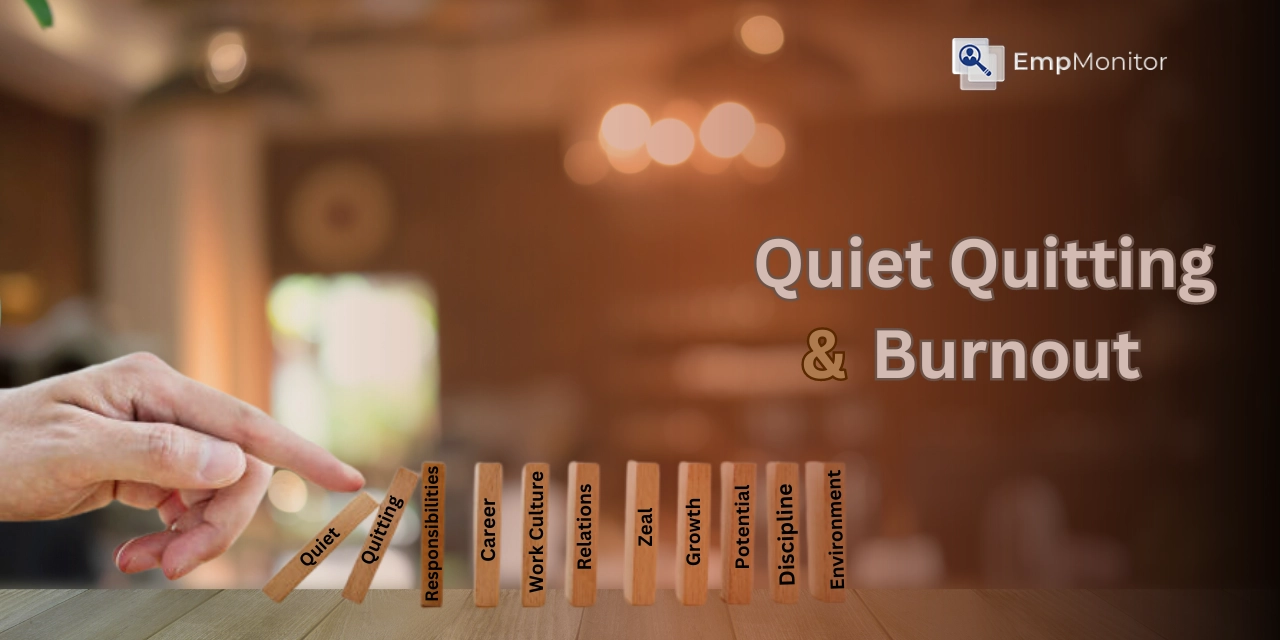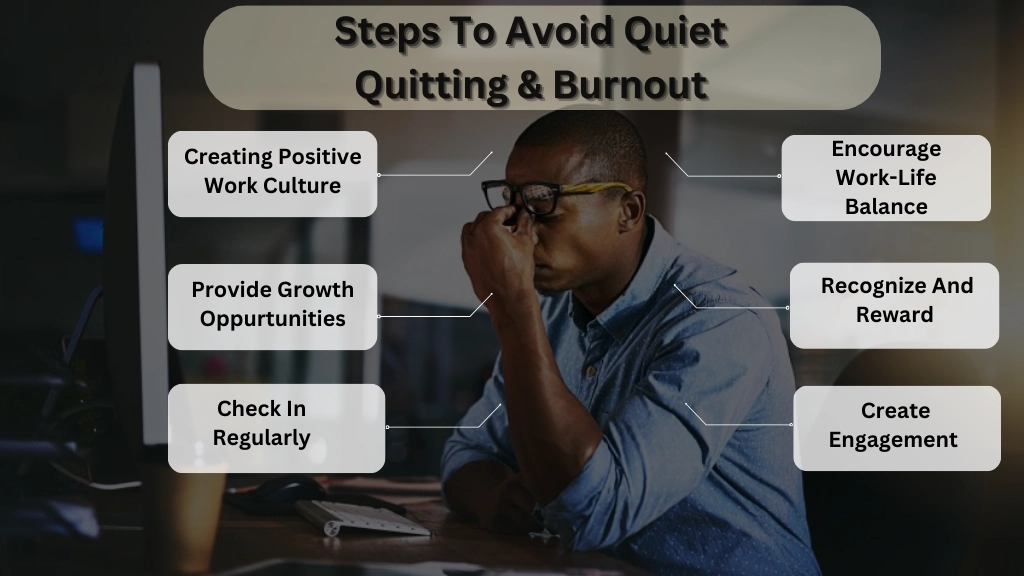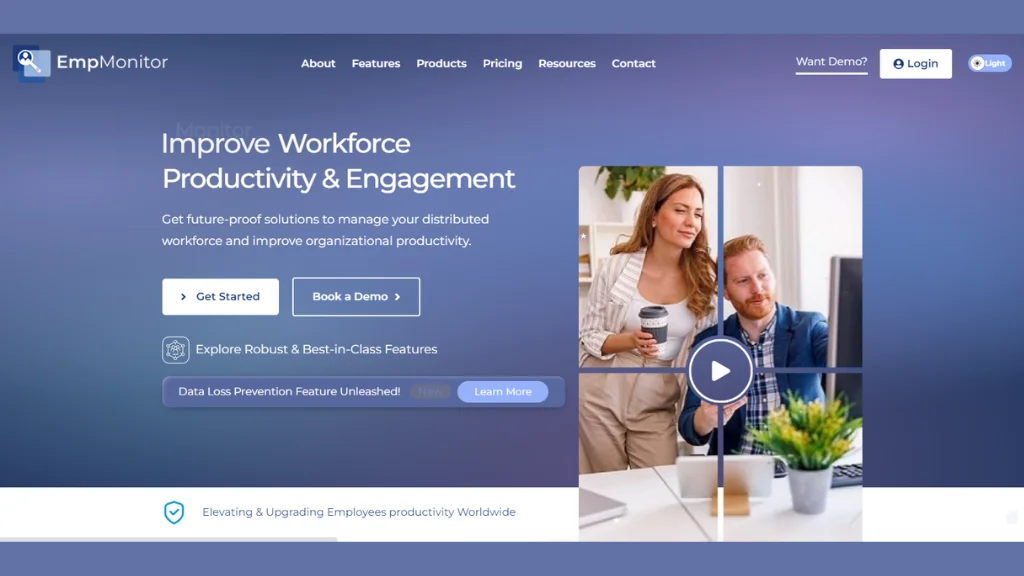The world went through a massive change in the last few years. Job losses, work-from-home and hybrid work culture had a great influence upon the work sector. Workers around the world suddenly were unemployed or over-worked. This created an environment of uncertainty and fear about jobs among employees.
And when there is uncertainty about a job, the will to work efficiently decreases. Which, in turn, led to a reduced commitment to work and further demotivated everyone. And the massive layoffs also put too much workload on a few workers. This forced the remaining employees to work overtime and thus get overburdened.
While some employees felt the brunt of overworking and felt burned out, others resorted to not working as efficiently as they used to, also called as-quiet quitting.
Thus, quiet quitting burnout has turned out to be the main reason causing problems for employers.
Listen To The Podcast Now!
What is Quiet Quitting, Burnout?
Quiet quitting can be termed as a simple protest, resistance, or setting of boundaries to a level where it starts affecting the company. In this form, employees choose to disengage themselves from work rather than confront their employer about dissatisfaction.
Although, quiet quitting does not actually mean quitting the job. It simply means doing as much as the job demands and the company pays them to do. Not doing the extra hours or just doing the bare minimum so as to stay on the job is called quiet quitting.
Well! We can say burnout is one of the reasons why employees initiate quiet quitting at work. When an employee is under some stress, be it personal or related to work, he feels extremely exhausted and unable to work properly and unable to meet deadlines. Due to the extreme mental pressure, the employee might get drained of energy, both physically and emotionally. This leads to a decline in the productivity of the team members.
While quiet quitting and burnout are terms taken together most of the time, both are also correlated. Let us learn how one leads to the other sometimes.
Reasons For Burnout:
While talking about employee burnout signs, there could be multiple reasons. Here are the 5 basic grounds of such happenings:
- Unreasonable Time Pressure: When the workload is heavy and the time is too little to complete, it becomes a reason for burnout of employees.
- Lack Of Role Clarity: If the role of the worker is not presented clearly and still gets dumped with a ton of work, it may lead to burnout.
- Lack Of Communication And Support From Managers: Every employer must have proper communication with the team members, lacking which the team members feel lost and mentally harassed.
- Unfair Treatment At Work: If the employer shows bias or favoritism to any particular worker, the other team members get demotivated and lose their focus on work.
- Unmanageable Workloads: The employers have to keep a watch if the workload is too much on any particular employee, as it can lead to him getting physically and mentally burned out.
How Burnout Leads To Quiet Quitting?
It is a trend that emerged during the early 2020s and spread largely through social media.
This is a problem as most of the jobs today require their employees to do some extra level of effort to collaborate with their co-workers and meet the needs of customers.
Quiet quitting burnout has become a headache for all employers worldwide. Many employees get frustrated and quit their jobs altogether, while some prefer the softer way of working, that is by quiet quitting.
Rather than getting stressed by the overwhelming amount of workload, they work less, just enough to let the managers know that they are productive. This is an efficient way of reducing work-related pressure and solve the issue of overworked employees.
But a question arises here, “Are burned-out employees quiet quitting their jobs?”
The answer is- Yes.
Some employees quit their jobs altogether. But not everyone is in a position to just let go of their job and the salary attached to it.
Hence, some burned-out employees started quiet quitting, which became a common way to cope with the ever-increasing workload.
You, as an employer, can spot the signs of quiet quitting burnout by noticing the following signs in your staff:
- Reduced Productivity
- Lack Of Engagement
- Lack Of Enthusiasm
- Reduced Quality Of Work
Quiet quitting burnout is a problem that employers face in every domain. When the pandemic hit, remote work culture increased leading to employees realizing that they need not work as efficiently as they used to. This term gained popularity with the help of social media and thus spread throughout the world.
But this also led to a decrease in remote work productivity of employees. And when productivity takes a hit, the business takes a hit too. So to avoid problems like quiet quitting burnout, employers can take certain measures.
Also Read:
7 Minute Employee Burnout Signs You Might Be Overlooking
How To Effortlessly Prevent Employee Burnout In An Organization?
Time Tracking Software For Employees: The Next Big Thing In Productivity Tools
Measuring Employee Productivity: The Key to Maximize Success
What Is Loud Quitting? Causes And Proven Solutions
Steps To Take To Avoid Quiet Quitting Burnout:-
Employers get frustrated with this form of work, where the bare minimum work is done, yet there is no certainty of meeting deadlines. So the most important question that arises here is “how to prevent quiet quitting burnout?”
Creating A Positive Work Culture-
A positive work culture benefits both the employers and employees. It makes the workplace and the work enjoyable. The employees do not have to drag themselves to work as they enjoy working there.
Provide Growth Opportunities-
The company should always be a place for the development and growth of employees. Employees should not feel trapped in the institution.
Check-In Regularly With Employees-
It is the duty of the managers to keep track of their employees and check in with them regularly. This would forge a better relationship among the employers and employees.
Encourage Work-Life Balance-
Employees should have a proper work-life balance so that they do not feel overburdened by their work and stressed out. Stressing out ultimately, leads to quiet quitting burnout.
Recognize And Reward Accomplishments-
Achievers and overachievers should get their work recognized and appreciated appropriately. This creates a sense of oneness and respect for the company in the employees.
Create Employee Engagement Ideas-
Employers should keep their workforce engaged so that they do not get bored in the monotonous workflow. New engagement ideas would create a refreshing atmosphere for the employees.
As an employer, you need to keep these things in mind so that your employees do not feel rejected or left out. And the best way to do all these is by the use of employee tracking software.
EmpMonitor is the best software for the hassles you may face while keeping track of your employees. Through the use of this software, you can easily counter the reasons behind employees’ quiet quitting burnout.
And how does this software help in this?
Let us learn how:
How EmpMonitor Can Help You With Employees’ Quiet Quitting Burnout?
EmpMonitor is the software that can handle all your worries in one place. It has all the required workforce management tools that can help you detect signs of quiet quitting-burnout and take steps to prevent it before it is too late.
This phenomenon is difficult to detect without the help of an employee monitoring software, as employees usually don’t communicate their dissatisfaction with the organization and feel that they cannot communicate it to their employers, making them disengaged from work.
This can happen slowly and over a course of time which can stay undetected. And these employees may start to reduce their efforts and productivity in a small way like avoiding responsibilities, taking longer breaks, or being unresponsive to communication and emails from their colleagues. And that ultimately leads to quiet quitting, burnout issues.
Here, an employee time tracking software, such as EmpMonitor can be used to recognize such employees. It can be used to track employee activity and behavior. Employers can identify the signs of employee disengagement or low productivity or other indicators that show that an employee may quietly quit.
It can also help to detect employees who are quietly quitting through the use of the following features.
They are:
Time Tracking Software-
Using this software, employers can monitor how much time employees spend on various tasks and projects. If your employees take longer breaks than normal and spend less time on work, it can be a sign that they are quiet quitting or getting burned out. Thus, a time tracking software is indeed necessary.
Performance Metrics-
Using this software, you can track performance metrics such as customer satisfaction ratings, productivity levels, and sales to identify patterns or trends that suggest that an employee may be quiet quitting.
Real-time Screen Monitoring-
Real-time screen monitoring can detect signs of low productivity or disengagement of employees, also called quiet quitting burnout. Using this software, you can see if the employee is spending more time on non-work-related websites or sites, you can understand that he is not engaged in his work.
Communication Monitoring-
Using EmpMonitor, employers can monitor the communication channels of employees such as email, chat, or messaging to identify any changes in their tone, frequency, or content. If an employee is communicating less and less or using more negative language than usual, it is a sign that he is getting disengaged from work.
Now let us see how it can help us solve the problem of quiet quitting & burnout. Using the latest software and technology, it can help employers detect employees who are quiet quitting or getting burned out.
Benefits Of EmpMonitor:
In today’s fast-moving world, retention of employees is a challenge faced by companies worldwide. Quiet quitting burnout leads to a lot of employees working but not producing results for the company.
Hence, companies need to use employee time tracking software to keep track of their productivity. And using this software can be highly beneficial for companies as it can benefit the company by helping stop burnout and quiet quitting in the following ways:
Early Detection-
It can help employers detect signs of disengagement or low productivity of employees early on or before they can escalate into bigger problems. By identifying the root cause, employers can address the issue proactively and thus create a more positive work atmosphere. This helps you to identify signs of quiet quitting, burnout much earlier.
Enhanced Security-
Prevention of data breaches and theft, protection of sensitive data, and monitoring for policy violations are some of the security features of this software. This helps the company protect itself against security risks and ensures employees follow company policies and guidelines.
Improved Communication-
Improved communication leads to a fall in quiet quitting burnout. This software includes features such as messaging and feedback tools which can be used to communicate with employees and provide feedback in real time. This can help improve the communication in your workplace and improve the morale of your workers.
Objective Performance Evaluation-
Employee monitoring software can help employers in providing objective data on employee performance, which can be used to evaluate their performance and identify the areas for improvement. It helps to ensure that employees are held to the same standards and that evaluations are unbiased and fair, thus reducing the chance of quiet quitting burnout.
Increased Productivity-
The most important part of any employee tracking software is to monitor employee activity and behavior which can help employers identify areas for improvement and thus provide support or resources as needed. This increases productivity and ensures that employees can do their jobs effectively.
To Conclude:
Quiet quitting & burnout is a phenomenon that is slowly affecting employees worldwide. And the best way to reduce this is to get into a flow state. It enables workers to perform at their peak and enter into a hyper-attentive phase.
This way employees become highly engaged and creative too. They get more work and better work done in fewer hours. This even starts to feel effortlessly productive. When they are in a flow state, they feel driven to work and the work starts to feel more and more effortless for them.
Working in a flow state leads to more productivity, learning speed at work, and creativity. When the work culture is fun, rewarding, and engaging, it becomes beneficial to both leaders and employees.
Finally, through early detection made possible by an employee monitoring software like EmpMonitor, businesses can reduce the issues of productivity loss, morale uncertainty, and other effects of quiet quitting burnout while ensuring that the most skilled staff remain to lead the organization forward.
















